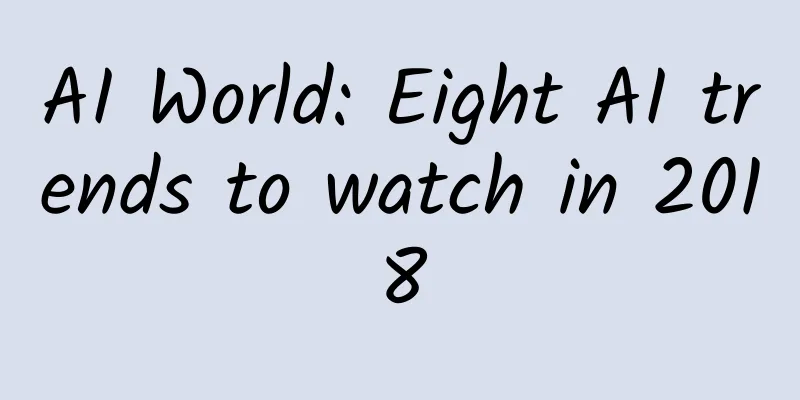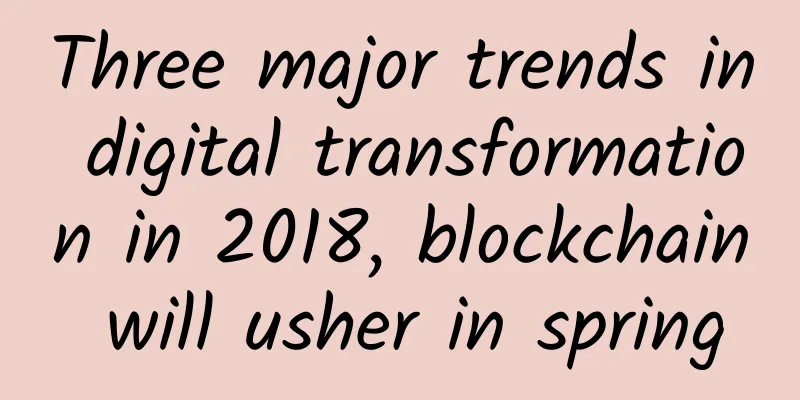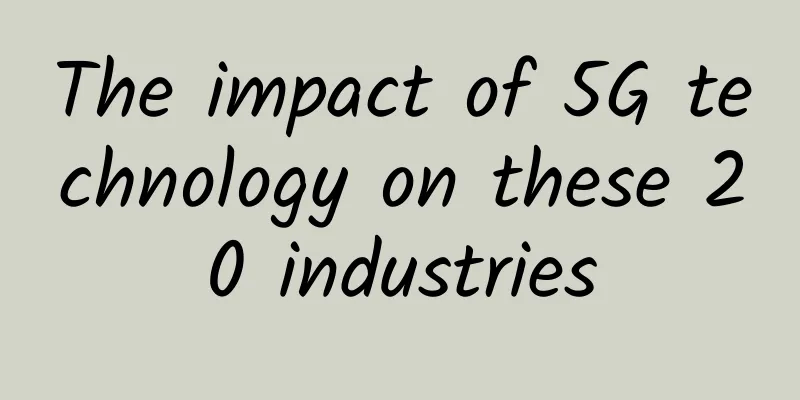AI World: Eight AI trends to watch in 2018

|
Computationally speaking, the big data analytics trend is not going away like a shooting star. As the amount of data continues to increase, the improvement of big data analytics will not stop. When it comes to predictive analytics applications, we have only seen the tip of the iceberg. Some organizations are using data mining, machine learning, and artificial intelligence technologies to analyze current data to better conduct business (e.g., predict sales, optimize marketing campaigns, etc.). All of these different types of artificial intelligence technologies have been closely combined to change our daily lives, and this change will continue. Here are some of the key statistics on AI, big data, predictive analytics, and machine learning:
Eight AI trends to watch in 2018 Trend 1 - Bigger companies will win in the future Amazon, Google, Facebook, and IBM will lead the development of AI technology. As large companies, they have more resources to collect data and thus have more data to work with. Here’s what the industry leaders are doing with AI: Amazon:
Google:
Facebook:
IBM:
Google is probably at the forefront of deploying machine learning for application and product development services. Not only is it the first company to conduct AI research, but it also has over 70,000 employees. Google is a very large company. In addition, Google Brain is a deep learning AI research project for which Google has an entire team. Google Brain research covers areas such as machine learning, natural language understanding, machine learning algorithms and techniques, and robotics. List of the 100 most promising artificial intelligence companies in the world Trend 2 - Algorithms and technologies will be integrated All the second-tier companies that have invested in AI (such as Intel, Salesforce, and Twitter) are following closely behind the companies with big data and starting to use their data algorithms and AI technologies. Data transactions will exist between industry users, and algorithms and technologies are likely to be integrated. Data transactions and the integration of algorithms and technologies will make AI more powerful. As big companies like Google and Facebook continue to acquire smaller companies, the algorithms in the hands of smaller companies will be integrated into the core platforms or solutions of the big companies. Google acquired DeepMind, a London-based artificial intelligence company that built a general learning algorithm, in order to gain a greater commercial advantage than other technology companies. On the other hand, Facebook acquired Wit.ai to help its own speech recognition and voice interface. It also acquired artificial intelligence startup Ozlo to improve the technology of its M virtual assistant. Trend 3 - The data crowdsourcing market will be huge All AI companies are eager to obtain large data sets in order to realize their AI ambitions. These companies will use crowdsourcing to obtain large amounts of data. There are already many different ways to evaluate the quality and reliability of crowdsourced data, which not only allows companies to benefit from this data, but also gives consumers a guarantee. "We live in a crowdsourcing culture where more and more people are willing and happy to share their knowledge through social media," said Joel Gurin, founder and editor of OpenDataNow.com. Google is crowdsourcing a vast amount of images to build imaging algorithms. It is also using crowdsourcing to help improve services such as translation, transcription, handwriting recognition, and maps. Amazon is also using crowdsourced AI to improve Alexa’s more than 15,000 existing features. Trend 4 - M&A, and more M&A According to statistics from CBInsights, the race to acquire artificial intelligence companies has begun. In 2018, we will see more mergers and acquisitions for intellectual capital and talent. All small companies in the field of machine learning and artificial intelligence will likely be acquired by large companies for two main reasons: AI cannot work independently without data sets. Since large companies have large data sets, small companies do not have much competitive advantage. Algorithms without data are of no use. Without algorithms, data is of little use. Data is the core of algorithms, and it is very important to obtain a large amount of data. “If data is the fuel, then algorithms are the engine,” said Hod Lipson, a robotics engineer and director of Columbia University’s Creative Machines Lab. Trend 5 - Democratizing tools to gain greater market share Large companies will open source their algorithms and tool sets to gain a larger market share. Market-based barriers to data and algorithm acquisition will be greatly reduced, and new applications of AI will increase. By democratizing tools, small companies that previously had limited or no access to AI tools will have access to large amounts of data to train and launch complex AI algorithms. Google CEO Sundar Pichai talked about democratizing AI: “One of the most exciting things we can do is to demystify machine learning and AI and make them accessible to everyone.” In addition, frameworks, SDKs, and APIs will become the standard for all major companies to guide consumer usage habits. SaaS and PaaS-based models will become the business models followed by all these companies. Trend 6 - Human-computer interaction technology will improve Siri and Alexa are probably the two most popular human-computer interaction tools. More robot-based solutions like them will become entry-level products for AI companies. For example, computers can currently be used for voice analysis and facial recognition, but in the future, computers will be able to identify a user's mood based on his tone of voice, which is called sentiment analysis. Solutions in manufacturing automation and non-consumer focus areas will be the first to improve. Improvements in manufacturing automation are mainly attributed to labor cost savings from the use of complex technologies including automation, robotics, and advanced manufacturing. In 2018, improvements in non-consumer solutions will be prevalent, such as human-machine interaction technology in agriculture and medicine. Trend 7 - AI will definitely impact all vertical industries Manufacturing, customer service, finance, healthcare, and transportation have already been impacted by AI. Self-driving vehicles are expected to be available in 2018. Next year, AI will impact even more vertical industries, such as:
The Industrial Revolution changed almost everything 100 years ago, and artificial intelligence will change the entire world in the next few years. Trend 8 - Security, Privacy, Ethics and Moral Issues Everything under the umbrella of artificial intelligence, including machine learning and big data, is vulnerable to new security and privacy issues. Sometimes, it is critical infrastructure that plays a role. Security needs related to privacy issues, such as keeping bank accounts and health information private, will rely more on security research. 2018 will be the year when security and privacy issues are resolved and there will be new developments. The ethics of AI will also be a major focus in 2018. Ethical and moral issues that need to be addressed include whether AI can harm or benefit humans. There are concerns that robots may replace humans, especially in areas that require empathy, such as nurses, physiotherapists, and police officers. Another issue to deal with is autonomous weapons. Consider a certain level of autonomous functionality, where AI should take over certain functions of a weapon, rather than humans fully controlling the weapon. Our recommendations Although AI has been around for many years, AI as we know it today is still in its infancy. There is a lot of hype around AI and its applications, from autonomous vehicles to virtual personal assistants and many other technologies that require human intelligence to complete tasks. While there are a large number of AI use cases, most of which are improvements to specific processes, it will take time to successfully deploy them. In addition, there are not many companies in the AI industry, so fragmentation will not appear for the time being, but unstructured data and algorithms to process this data will appear. The road to AI is long and arduous. |
<<: Basic knowledge of wires and cables
>>: Machine Learning in Blockchain Technology
Recommend
Health and Risk: A New Model for Data Center Capacity Management
Some analysis companies believe that capacity man...
What role can fiber optic technology play in education?
In the ever-evolving field of education, technolo...
Network upgrades you should consider in 2021
As 2020 winds down and the new year dawns, it pro...
AI and Wi-Fi 6: Driving the Revolution in Home Wi-Fi
As fixed networks enter the F5G (fifth generation...
A divorce war triggered by a WeChat chat!
I couldn't help laughing when I saw these two...
Why haven’t white box vendors penetrated the large enterprise market? How can they change that?
According to IDC's latest survey data, global...
TCP/IP Appetizer: HTTP
[[381273]] This article is reprinted from the WeC...
Site24x7 enters China's cloud monitoring market and opens Shanghai data center
On March 12, 2019, Zoho Corporation announced the...
Kunpeng spreads its wings in Guangdong and the Bay Area | Kunpeng and his friends propose new computing to empower government smart office
[[350382]] At 14:00 on the afternoon of October 3...
DigitalVM: 50% off on all VPS, 1-10Gbps unlimited traffic starting from $4/month in the US/Japan/Singapore
Digital-VM is a foreign VPS service provider esta...
API Gateway: Layer 8 Network
An API is a set of rules that govern the exchange...
Practice on optimizing VUA forwarding performance of vivo unified access gateway
VLB stands for vivo load balance. As the IDC traf...
How many hurdles will computing power development have to overcome in the future?
At present, the digital economy is entering a new...
6 AI Elements You Need for a Wireless Network Strategy
Thanks to advances in artificial intelligence (AI...
edgeNAT April Fools' Day event offers 30% off monthly payment and 40% off annual payment, Korean/US/Hong Kong VPS starts from 42 yuan per month
Today is April Fools' Day, but the promotion ...









